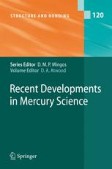Search
Search Results
-
Carbene Complexes of Heme Proteins and Iron Porphyrin Models
The possible formation of carbene complexes of cytochromes P450 enzymes in various metabolisms of xenobiotics is first described. In view of these...
-
Ferrocene–Peptide Bioconjugates
This chapter sketches an outline of ferrocene–peptide bioconjugates. A variety of ferrocene–peptide bioconjugates have been designed to induce...
-
Catalytic Nickel–Iron–Sulfur Clusters: From Minerals to Enzymes
The geochemical theory of the origin of life proposes that primordial, pre-biotic reactions were carried out in a metal-sulfide-rich environment...
-
Sequentially Palladium-Catalyzed Processes
Sequentially palladium-catalyzed reactions consist of combinations of identical, related, or significantly different palladium-catalyzed processes...
-
Structural Aspects of Layered Double Hydroxides
Layered double hydroxides (LDHs) have been known for a considerable time and have been widely studied. The basic features of their structure,...
-
n-Body Decomposition Approach to the Calculation of Interaction Energies of Water Clusters
A new methodology is proposed in which large basis set MP2-level calculations can be extended to water clusters with as many as 50 monomers. The...
-
Multiporphyrin ArraysAssembled Through Hydrogen Bonding
Although relatively weak in isolation, composite H-bonds can be used as an advantage for the assembly of relatively robust and well-defined arrays...
-
Axial Coordination to Metalloporphyrins Leading to Multinuclear Assemblies
The use of axial coordination to metalloporphyrins is discussed on the basis of constructing multinuclear complexes. Starting with single...
-
Poly(mercaptoimidazolyl)borate Complexes of Cadmium and Mercury
The coordination chemistry of bis- and tris(mercaptoimidazolyl)borate ligands with both main-group and transition metals is rapidly expanding....
-
Mercury Removal from Water
Mercury pollution in water is a serious threat to natural ecosystems. Various methods and technologies are in use to remove mercury from the...
-
Intermolecular Interactions via Perturbation Theory: From Diatoms to Biomolecules
This article is devoted to the most recent, i.e. taking place within the last few years, theoretical developments in the field of intermolecular...
-
Nucleation and Crystallization in Diblock and Triblock Copolymers
Crystallization of block copolymer microdomains can have a tremendous influence on the morphology, properties and applications of these materials....
-
Block Copolymer Micelles
This review summarizes recent advances to date in the area of block copolymer micelles and also tries to highlight some new directions in that...
-
Surface-Grafted Polymer Gradients: Formation, Characterization, and Applications
This review presents to-date progress in the formation of surface-tethered polymer assemblies with gradually varying physico-chemical properties....
-
Computer-Aided Conformation-Dependent Design of Copolymer Sequences
A survey is given of the simulation methods as applied to the design of nontrivial sequences in synthetic copolymers aimed at achieving desired...
-
Polymer Brushes by Anionic and Cationic Surface-Initiated Polymerization (SIP)
The formation of homopolymer and block copolymer brushes grafted from flat and nanoparticle surfaces via surface-initiated anionic and cationic...
-
After-Action of the Ideas of I.M. Lifshitz in Polymer and Biopolymer Physics
We review the development of ideas in polymer physics initially formulated by I.M. Lifshitz. We start with general issues in polymer statistics,...
-
Surface Rearrangement of Diblock Copolymer Brushes—Stimuli Responsive Films
This article reviews results from our group of the synthesis and characterization of diblock copolymer brushes. Results from the literature are...
-
Role of Physical Factors in the Process of Obtaining Copolymers
A brief introduction into the principles of the statistical description of the chemical structure of linear heteropolymers is given....
-
Self-Association of Phosphorylase Kinase under Molecular Crowding Conditions
Self-association of phosphorylase kinase (PhK) has been studied using analytical ultracentrifugation and dynamic light scattering under the...
